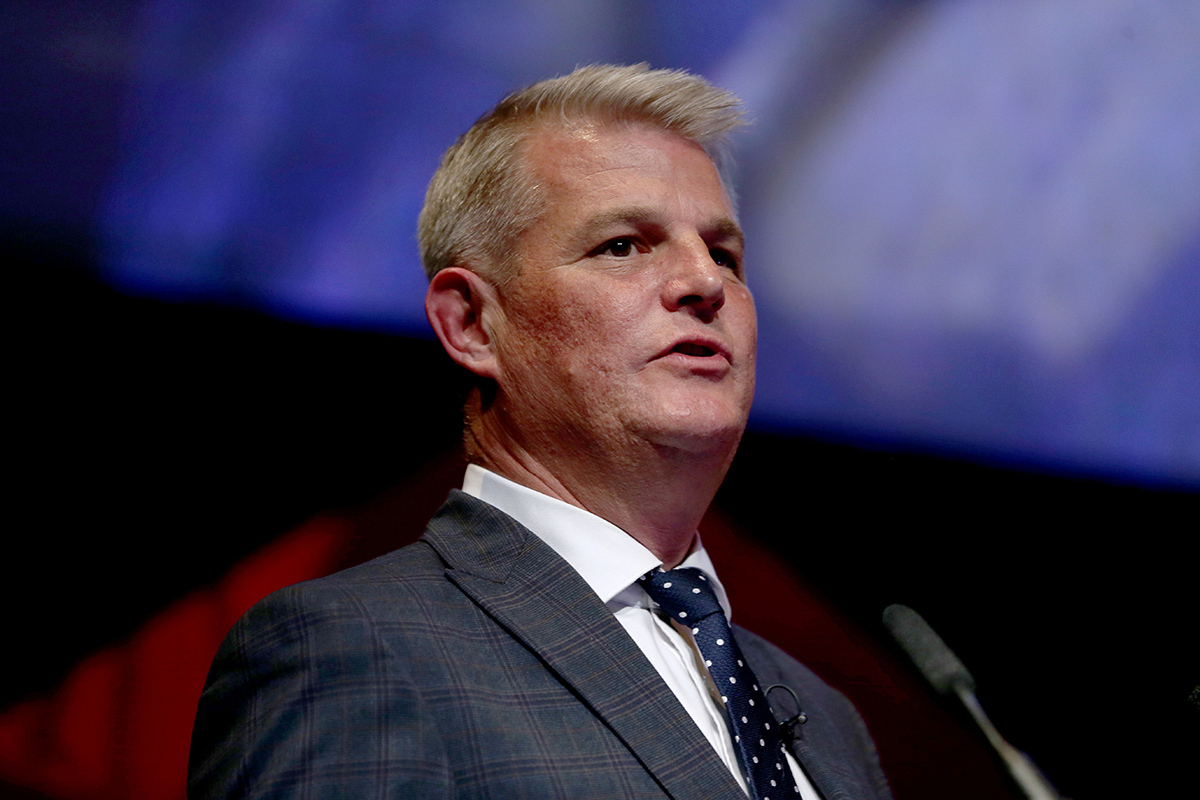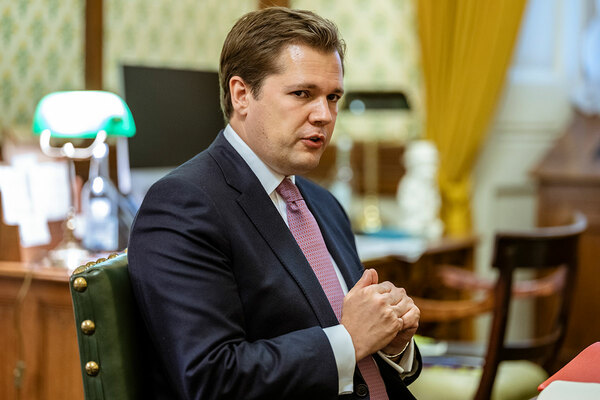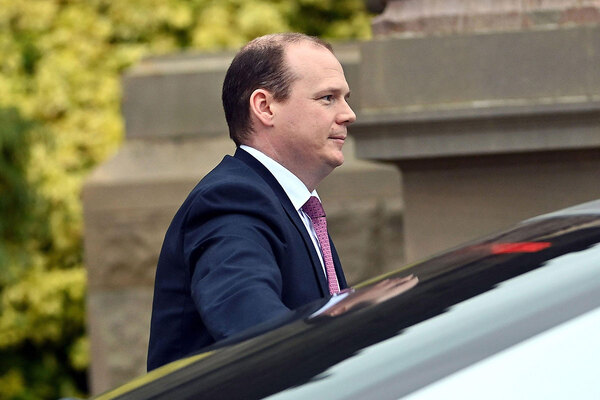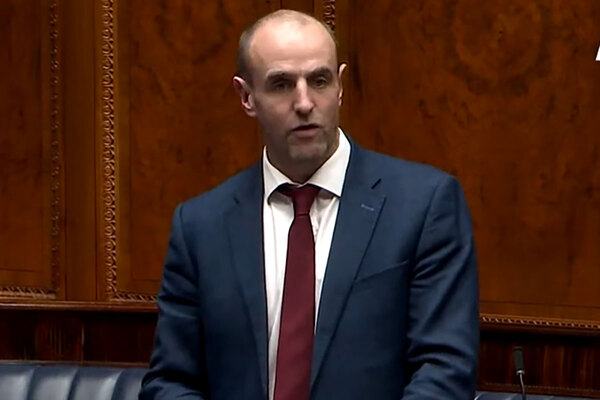You are viewing 1 of your 1 free articles
Timeline: the 20 housing ministers since 1997
The transience of housing ministers continues. As Stuart Andrew resigns after just 148 days in the role, Inside Housing looks back at all 20 housing ministers since 1997
Stuart Andrew: February 2022 to July 2022
The MP for Pudsey barely had time to introduce himself to the sector before resigning from his position, following a scandal involving his predecessor, Chris Pincher.
Serving in the role for just 148 days, Mr Andrew’s resignation allowed him to usurp Dominic Raab as the shortest-serving housing minister since the role was created in 1997.
The resignation came one week after Mr Andrew addressed the Housing 2022 conference in Manchester, promising reforms to get councils building more and recommitting the government to its 300,000-homes-a-year target.
However, Mr Andrew was gone before we got a chance to see whether he would be able to deliver on these ambitions.
Chris Pincher: February 2020 to February 2022
One of the longer-serving housing ministers, Mr Pincher was appointed to the role in February 2020, just weeks before the national COVID-19 lockdown.
The MP for Tamworth arrived at the department then known as the Ministry of Housing, Communities and Local Government (MHCLG) from the Foreign Office, where he was minister for Europe and the Americas.
It would emerge years later that Boris Johnson, the prime minister, was made aware of claims that Mr Pincher behaved inappropriately at the Foreign Office, but was still given the housing minister role.
During his two-year stint, the COVID-19 pandemic dominated MHCLG policy.
The department, then led by housing secretary Robert Jenrick, brought in a number of policies to try and stop the spread of the virus. These included a two-month freeze on the housing market, with the buying and selling of homes banned, as well as an evictions ban which stopped landlords from removing tenants from their properties while the pandemic was at its height.
But he was known for what he didn’t push through as much as what he did. In July 2020, he said there would be a delay to long-promised reforms of the private rented sector, including the scrapping of no-fault evictions, until the coronavirus situation had been dealt with.
Other key housing reforms, such as the Social Housing Regulation Bill promised immediately after the Grenfell Tower fire, were not put in front of parliament during his two-year stint.
Mr Pincher and Mr Jenrick were also unable to get on top of the building safety crisis.
While the department did manage to get the Treasury to commit £3.5bn towards remediation of dangerous cladding, the department also put forward the ill-fated plan for a loan scheme for leaseholders in buildings lower than 18m in height.
Mr Pincher was moved to the role of deputy chief whip after a reshuffle in February 2022. He was forced to resign from this role in July 2022 following allegations about his conduct.
Esther McVey: July 2019 to February 2020
The former TV presenter, who first entered parliament in 2010, wasted no time in taking to Twitter after being sacked as housing minister and said she was “very sorry to be relieved” of her duties.
In her eight-month stint in the job, Ms McVey kicked off by pushing the idea of homeownership. The shift in policy under Boris Johnson is a return to the focus on ownership seen during David Cameron’s premiership.
But reports surfaced last month that Ms McVey had been involved in a spat with her boss, housing secretary Robert Jenrick, over whether the government should invest in building more council housing or help first-time buyers. Ms McVey, who ran in the Conservative leadership contest last year, was reportedly arguing for the former.
She also pushed the idea of modular housing, calling for the UK to become a “world leader”, and talked of protecting the green belt. Ms McVey, whose seat is George Osborne’s former constituency of Tatton, was also forced to defend the government’s position on the cladding crisis – speaking on the issue in a parliamentary debate just yesterday.
Kit Malthouse: July 2018 to July 2019
The MP for North West Hampshire’s time as housing minister will perhaps best be remembered for his parroting of the slogan “more, better, faster”. This policy approach was when the Conservatives had pledged to build 300,000 homes a year, which has now been downsized to a million new homes by the mid 2020s.
Mr Malthouse, also a former Conservative leadership hopeful, urged housing associations and councils to “step forward” to help hit that target.
He appeared to take an interest in the social housing sector and in an exclusive interview with Inside Housing in July said council housing was “coming back with a vengeance” and vowed to reform the Right to Buy. Mr Malthouse also asked officials to “explore strengthening” planning guidance to prevent segregation of social housing residents.
Dominic Raab: January 2018 to July 2018
The former Vote Leave campaigner was always going to be a slightly odd fit for the housing minister role, with his long-standing and vocal opposition to green belt development.
In six months he never quite escaped the impression that his appointment had as much to do with balancing the amount of Leave MPs in ministerial roles as it did about any interest in housing.
His move to take the role as secretary of state for leaving the European Union will only add to this impression.
His comments about housing and immigration – for better or worse – will be what his tenure is best remembered for.
Alok Sharma: June 2017 to January 2018
Mr Sharma’s short tenure as housing minister was mostly taken up carrying out roadshows with tenants to gather evidence for the forthcoming Social Housing Green Paper.
Mr Sharma got good reviews for his willingness to listen in these meetings, and a leaked letter revealed he took on board criticism over issues such as the affordable rent regime.
However, he was moved on to a role in the Department for Work and Pensions without being given time to implement any of his findings.
Gavin Barwell: July 2016 to June 2017
Mr Barwell was arguably the most popular housing minister of this period with the sector, having led a change in housing policy away from the homeownership-focused era of Mr Cameron’s government to a more multi-tenured approach.
He worked on the Housing White Paper and oversaw the dropping of unpopular Starter Homes targets and the effective kicking into the long grass of the high-value asset levy.
He lost his seat at the general election in 2017, but was appointed as Theresa May’s chief of staff. His position will, however, be forever tainted by a failure to review building regulations ahead of Grenfell – a failing which could equally be ascribed to all of his predecessors.
Brandon Lewis: July 2014 to July 2016
The only minister to have matched Grant Shapps’ two-year tenure, Mr Lewis’ role came during a time of transition in housing policy.
When the Conservatives won a majority in 2015 and embarked on a new style of housing policy, including removing all grant for low-cost rent and extending the Right to Buy to housing associations, Mr Lewis was an enthusiastic champion.
He led a bad-tempered battle with the House of Lords over the Housing and Planning Act and claimed households on housing waiting lists would be able to get mortgages to buy Starter Homes.
An ally of Ms May, he took roles in the Home Office and later became party chair following her appointment as prime minister.
Kris Hopkins: October 2013 to July 2014
This is when the merry-go-round really got spinning. Mr Hopkins, a former soldier, had a short stint in the role and is not widely remembered for any major policy changes.
He caused some controversy by suggesting it was OK for private landlords not to rent to tenants on housing benefit and for suggesting that it wouldn’t be difficult to re-let properties due to welfare reform.
He moved from the housing brief to take up a role with responsibility for several areas, including community pubs, and lost his seat as an MP in the 2017 election.
Mark Prisk: September 2012 to October 2013
Mr Prisk’s year in the job was spent mostly behind the scenes, prompting an Inside Housing profile which branded him ‘the invisible Mr Prisk’. Nonetheless, he was well thought of by sector figures and spoken of with more fondness than the more exuberant Mr Shapps.
Mr Prisk was at the helm when Help to Buy was introduced, however the policy is seen as one developed by the Treasury. A chartered surveyor by trade, he is a rare housing minister to have had a background in housing.
Grant Shapps: May 2010 to September 2012
The longest-serving housing minister in the modern Conservative era, Mr Shapps passed the two-year mark in his role.
Remembered particularly for his abolition of the Tenant Services Authority (“the TSA is toast,” he said), Mr Shapps also oversaw a giant reduction in grant for affordable housing and the introduction of the ‘affordable rent’ regime to replace socially rented housing.
He left when appointed chair of the Conservative Party.
John Healey: June 2009 to May 2010
Now a long-time voice on housing issues in parliament, Mr Healey spent just under a year as housing minister under then-prime minister Gordon Brown.
The Labour stalwart, who was briefly a journalist in his early career, attracted criticism in right-wing quarters during his stint by suggesting that a fall in the number of people owning houses was a good thing.
During his spell he also vowed to amend planning rules to make homes more environmentally friendly and called for people living in shared ownership homes to be able to sell some of the equity in their homes back to their landlord.
Since then he has been a keen supporter of the sector and helped launch the Social Housing Under Threat campaign in 2014 to defend social housing.
He was once reported to keep a white hard hat with the Labour logo ‘a future fair for all’ on it in his Westminster office. Apparently it is a souvenir from visiting building sites during his time as housing minister.
Margaret Beckett: October 2008 to June 2009
The Labour veteran spent nine months as housing minister while Mr Brown occupied Number 10. Ms Beckett, who was first elected as an MP in 1974, called on councils to be given a bigger role in housebuilding during her time. She was also forced to distance herself from reports that Labour was thinking of scrapping lifetime tenancies.
Caroline Flint: January 2008 to October 2008
The now former Labour MP for Don Valley was another to hold housing’s poisoned chalice briefly during Mr Brown’s reign. During her time she unveiled a “rescue package” for housing, including a ‘Rent to Buy’ scheme, allowing households to rent homes at a discount while saving money for a deposit to buy a stake in a property.
Yvette Cooper: May 2005 to January 2008
Now a Labour stalwart, Ms Cooper was a relatively long-standing housing minister who spent over two-and-a-half years in the job, first under Tony Blair and then Mr Brown. During her time she had to face up to criticism over the government’s emphasis on homeownership.
Keith Hill: June 2003 to May 2005
Again a relatively long-serving housing minster, spending nearly two years in the job during Mr Blair’s premiership. He was MP for Streatham from 1992 until 2010, when he stood down.
Lord Rooker: May 2002 to June 2003
A long-standing member of the Labour Party, Lord Rooker first became an MP for Birmingham, Perry Barr in 1974 before stepping down in 2001 and becoming a life peer. In 2002 he became minster for housing and planning, a role he held between May 2002 and June 2003. In September 2003, a number of tenants advisors attacked his seemingly supportive stance in promoting stock transfers across the country after he told attendees at the National Housing Federation conference that he wanted to “drive the transfer forward rather than be reactive to it”.
Lord Falconer: June 2001 to May 2002
Baron Falconer of Thoroton – or Charlie Falconer – served as housing and planning minister for 11 months between June 2001 and May 2002 before moving on to a job in the Home Office. The former barrister and flatmate to Mr Blair later became chair of housing association AmicusHorizon, which is now a part of Optivo.
Nick Raynsford and Hilary Armstrong: May 1997 to June 2001
Holding the role for four years between 1997 and 2001, Mr Raynsford is one of the longer-standing housing ministers from the past two decades. His main focus was the delivery of the Decent Homes Programme, which saw millions of social homes upgraded to meet new standards. He is currently chair of the Town and Country Planning Association and has penned two reports criticising the planning system.
Former MP for North West Durham Ms Armstrong shared the housing brief with Mr Raynsford while minister of state at the Department of Environment, Transport and the Regions between 1997 and 2001.
Sign up for our Week in Housing newsletter
Already have an account? Click here to manage your newsletters












